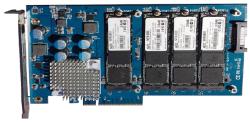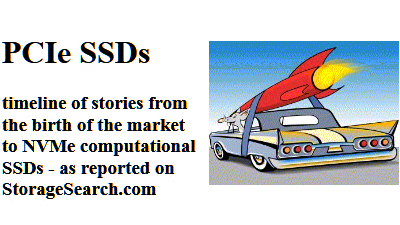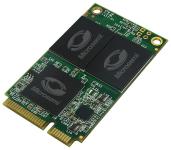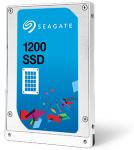 |
| leading the way to the
new storage frontier | |
... |
| ..... |
|
SSD endurance
SSD market
history
can you
trust SSD market data?
Surviving SSD
sudden power loss
The enterprise
flash story... could it have been simplified?
Decloaking
hidden preference segments in enterprise flash
|
|
| . |
|
 |
|
| . |
|
| what just happened in SSD
land? |
by
Zsolt Kerekes,
editor - StorageSearch.com
If,
like me, you temporarily stepped aside from the flood of
SSD market related news any
time during the past 4 weeks or so for a vacation or other reasons then what
can I tell you so that you feel more back in control?
Undoubtedly (in
my mind) the most significant enterprise flash related news in recent years was
Diablo's
Memory1.
Much
less easy to place within any particular calendar year and to rate for its
significance to future
SSD history
- however - due to its distinctly vaporware-like aspects and stunning lack
of technical details - was the stage managed unveiling of a newly branded
memory architecture by Intel
and Micron -
which (like the emperor's new
clothes) may or may not become significant for enterprise applications in
2016, or 2017 or 2018 - depending on when we can see it working and depending on
what other competitors are doing at that time.
For
PCIe SSD watchers -
there were incremental advances in
PCIe
fabric as PMC-Sierra
showed it could get switches and flash to talk the same language together
across rack boundaries using NVMe and RDMA.
As you'd expect - the
usual sprinkle of SSD companies emerged from stealth mode.
This
included not just VC
funded revenue hopeful startups but also some significant customer
revenue funded companies too - which had developed quietly in China and
decided that maybe the rest of the world should get to hear about them too. (One
example in this "how come we didn't notice them before?" category -
being Longsys -
which to my embarrassment was already an $800 million revenue flash products
related business before it appeared this year in my SSD radar.)
And
what about indicators along the
bumpy
road to eventual consolidation in enterprise SSD platforms?
Two
recent indicators have been:-
Some of the above developments can also be seen as fitting
into a pattern of developments which will make 2015 stand out in a unique way in
SSD adoption history.
- the anticipated
compelling need for enterprise SSD storage drive makers to have rackmount
system products too - due to efficiency gains which are only possible at this
level of integration - due to cumulative gains made at many different levels in
software.
- the shift of the fast SSD accelerator center of focus to its 3rd
market territory in the past 16 years -
DIMM wars -
which will displace and change the positioning of latency
heirarchy for
PCIe SSDs.
| | |
|
| . |
|
 |
|
| . |
|
| Intel will enter Memory
Channel SSD market |
Editor:- August 24, 2015 - Back in
July Intel and Micron
unveiled
a new bulk material based resistive memory nvRAM platform which they called
3D
XPoint™ technology (later branded as Optane). At that time - the
technical information about the memory technology were vague and lacking in
detail.
More details emerged during the shows which immediately
followed (FMS and IDF) and here's a link with the
webcast.
Intel
says cost per bit is likely to be somewhere between DRAM and nand flash.
Latency
is said to be 1,000x faster than nand but slower than DRAM.
Storage
density? A single chip can store 128Gb.
Sampling? Later this year with
production in 2016.
Some of the many form factors and attach points
which might benefit from this new technology are PCIe SSDs and Memory Channel
SSDs.
As with any new memory technology it will take time and
experience to prove whether Optane memory has enterprise grade reliability. For
this reason and due to the need to establish a new software ecosystem - early
uses of the memory will probably be in experimental cloud appliances and
consumer gaming devices.
...Later:- Initially I had serious
doubts about the market readiness state of the Intel / Micron preannouncement
because it appeared to leapfrog previously known memory offerings. And
storage history has
taught us 2 valuable lessons about new memories.
- the new memory is usually a small increment (2x, 4x etc) what was done
before - to minimize the risk of new problems creeping into the next scaled
geometry iteration, and
- I've heard such "market breakthough stories"
from the anti-flash nvm world many times in the past 12 years - usually
precipated by a need for more investment cash.
Where can you find more
reliable information about ReRAM?
I've found a website which seems to
have a more measured and informed approach to what has been happening in ReRAM
land - and reading it may help you guess better when these advances might
really intersect with the mainstream SSD market.
Take a look at
http://www.reram-forum.com
See
also:- flash and nvm
news here on the mouse site | | |
|
. |
|
 |
|
. |
|
| what can we learn from Pure
Storage's IPO filing? |
Editor:- August 14, 2015 - Pure Storage
needs more funds to continue its current growth strategy in the
rackmount SSD market.
The reasons become clear in the details revealed in the
FORM
S-1 which the company registered recently with the
SEC for an IPO.
One interpretation
is that the company's R&D and sales and marketing costs have been
disproportionately high relative to their revenue - judged by steady state
market standards. However, if you choose to assume that the company's revenue
will continue to grow rapidly - then these front end loaded losses are not
dissimilar to what we have seen in many previous enterprise SSD IPOs.
Interesting things which emerge from Pure's S1.
- Pure Storage's revenue in the year ending January 31, 2015 was just under
$155 million.
- Pure Storage has over 1,100 customers. And coincidentally - 1,100
employees. (Is 1 to 1 a sustainable ratio?)
Maybe because of that Pure
has a good story to tell about repeat business - although warns that this is
based on a short history of 27 months of selling systems and that things could
change.
- silliest statement in the S-1:- "We have pioneered the all-flash array
category..."
- most profound statement in the S-1:- "The market for all-flash
storage products is rapidly evolving, which makes it difficult to forecast
customer adoption rates and demand for our products."
Investors
make decisions based on all kinds of criteria and sometimes these don't make
sense to anyone else - or even to the same person when looking back later. So
I'm not going to speculate on the gambling aspects of the IPO.
Instead
this is a useful opportunity to remind you that in the timeframe of the next 3
to 5 years there will be a great deal of market change and consolidation in the
enterprise flash array market for reasons and with possible transformation
paths which I wrote about in
a
recent article.
So if I'm trying to figure out the strengths and
weaknesses of how a company like Pure Storage might morph and survive into that
kind of future market my guesses would hinge around these factors:-
- hardware:- companies like Pure (and most others too) will be buying all
their hardware boxes from 3rd parties in the future. Pure's hardware IP is
minimal today. But this doesn't matter so much.
- software and marketing:- these are the things which will matter.
Pure
has demonstrated that it can sell systems - although it's hardly unique in
that. And while Pure is currently a small and costly sales channel compared to
the rest of the market it competes with - some longer established competitors
are much worse.
So the question is - can its software (its real core
asset) stand up competitively compared to new upcoming generations of
industry standard enterprise flash management software which will become the
norm?
And an equally important question related to software - is what
proportion of the future flash array market will actually need to be backwards
compatible with legacy architectures?
That after all is the main point
of Pure's business model today.
So you might think about scaling
back down the IDC numbers
mentioned in the S-1 or look at the detail or - better still -
completely
disregard them if you're looking at TAM for Pure style flash arrays.
Of course I'm posing these questions knowing that reliable answers
are unknowable. But despite all the uncertainty the beauty of the competitive
capitalist free market system is that useful stuff still gets done and when
companies become publicly owned the market provides real time feedback of what
investors think. | | |
|
| . |
|
1x M.2 NVMe PCIe SSD good
4
is better - says Memoright |
| Editor:- August 16, 2015 - Memoright discussed
the possibilities arising from using an array of 4x
M.2
NVMe PCIe SSDs packed onto a single PCIe switch card as a way of building
competitively priced SSD accelerated servers - in a paper
Using
a PCIe-Based Switch Module to Enhance Enterprise Storage Architecture (pdf)
presented at the recent Flash
Memory Summit. |
 |
Each of the new M.2 SSDs from Memoright would
have upto 1TB capacity and R/W IOPS upto 81K / 54K respectively.
This
is the familiar kind of density story we've seen throughout SSD history, which
has applied to slots of all sizes from DIMMs to rackmount shelves, which is
that some integrators will find applications which benefit from filling every
conceivable slot with the maximum number of new SSDs which thermal sanity will
allow. | | |
|
. |
|
 |
|
. |
|
| Waitan has embeddable
industrial grade ejector for 1.8" microSATA SSDs |
Editor:- August 5, 2015 - I wasn't really
expecting to see any major product innovations in the embedded
1.8" SSD market - but
even long established markets can spawn specialized developments.
Something
like that can be seen in the shape of the recent launch by Waitan of a patent
pending 1.8" microSATA SSD ejector product with dual propel pedals for
smooth and even ejection for use on PCBs. |
 |
| Carina Li, Waitan's Product Manager says
the new connector will enable designers to deploy 1.8" microSATA SSDs with
the same ease and serviceability and EMC shielding benefits as 2.5" SATA
SSDs. ...more
info (pdf) | | |
|
. |
|
|
|
| |
 |
| ... |
|
|
Violin's revenue declined 18% compared to
year ago quarter
Editor:- August 27, 2015 - Violin Memory today
reported
that revenue for the quarter ended July 31, 2015 was $15.3 million - which was
18% lower than the same period a year earlier.
Editor's comments:-
Violin's revenue in calendar year 2014 was about half that of
Pure Storage.
But here's a cautionary note:- "Pure Storage has over 1,100
customers. And coincidentally - 1,100 employees. (Is 1 to 1 a sustainable
ratio?)" - from the article - what can we learn from Pure Storage's IPO
filing? (in the column on the left of this page)
3D TLC is good enough to last 7 years
in 1 DWPD Kaminario
customer base
Editor:- August 21, 2015 - One of the early
new SSD
ideas in 2014 was that 3D nand flash was tough enough to consider using
in industrial SSDs so it was no surprise when 3D flash started to appear in
volume production of enterprise SSD accelerators such as Samsung's 10 DWPD
NVMe PCIe SSDs in September
2014.
So the recent
announcement
by Kaminario
that it will soon ship 3D TLC (3 bits) flash in its K2 rackmount SSDs can be
seen as a predictable marker in the long term trend of
flash adoption in
the enterprise.
Less predictable, than the price (under
$1,000/TB
for usable systems capacity) however, is that Kaminario is offering a 7
years endurance related systems warranty.
This
factor - discussed in a
Kaminario
blog - tells us more about Kaminario's customer base than it tells us about
flash endurance
however.
Kaminario says its HealthShield "has been collecting
endurance statistics for the past few years, and from analyzing the data we see
that 97% of (our) customers are writing less than a single write per day (under
1 DWPD) of the entire capacity."
This is one aspect of a trend I
wrote about a few years ago -
thinking
inside the box - which is that designers of integrated systems have more
freedom of choice in their memories than designers of standard SSD drives -
because they have visibility and control of more layers of software and can
leverage other architectural factors.
A competent box level SSD
designer can make better decisions about how to translate raw R/W intentions
(from the host) into optimized R/W activities at the flash .
This
is especially the case when the designers are also collecting raw data
about the workloads used in their own customer bases. The customer experience is
more important than slavishly designing systems which look good in artificial
benchmarks.
Seagate will acquire Dot Hill
Editor:- August 18,
2015 - Seagate
today
announced
it will acquire Dot
Hill Systems in an all-cash transaction valued at $9.75 per share, or a
total of approximately $694 million.
Editor's comments:- this
is a good strategic move for Seagate which now secures an enterprise market
proven hybrid storage caching and tiering technology which can be used as a
framework for hybrid
appliances and cloud
infrastructure.
The enterprise software stack and patent IP assets
from Dot Hill will enable Seagate to credibly position its SSD caching
technologies as second to none in mid range traditional
legacy
enterprise environments.
Dot Hill's marketing had been foundering
around for a few years and the company was seemingly unable to get the kind of
market attention it would have got if it were offering the same technology as a
startup. Part of the problem was that - as an old time company from the
dotcom era -
which had relied on 3rd party companies oeming its products - Dot Hill had
neglected to develop the same kind of marketing charisma and brand identity as
many of the newer companies which it has been competing with.
As
part of Seagate - Dot Hill 's caching technology could become a viable
alternative platform for integrators who want to compete with newer vendors
Tegile,
Nimble,
NexGen and hybrids from
older vendors like HP and
EMC.
is the hyper convergence market over indulging in hype?
Editor:-
August 18, 2015 - some interesting comments about the reputation inflationary
role of
market research
soothsayers in the hyperconverged systems market surfaced in a
recent
blog by Chin-Fah
Heoh, StorageGaga - who
says - among other things:-
"Hyper Converged vendors spend a lot
of their resources and marketing on hyping up performance, and little on
everything else." ...read
the blog
Radian's Symphonic - Most Innovative Software at FMS
Editor:-
August 18, 2015 - Radian
Memory - which recently emerged from stealth mode - today
announced
it had received a best of show award at the
Flash Memory Summit for
"Most Innovative Software Technology".
This was for its
software product Symphonic -
designed for its new 2.5" NVMe SSDs - which replaces the traditional FTL
controller approach
with a 3rd generation approach - described by the company as "Cooperative
Flash Management" - which partitions data movement responsibility
between the controller in the SSD and the host CPUs and which enables data
to be moved around the flash array under host control without needing to be
read back into main system memory.
Microsemi fills key gap in TRRUST-Stor military SSD line
Editor:-
August 14, 2015 - Microsemi
recently added a low power MO-300 mSATA SLC SSD to its
TRRUST-Stor®
family of secure
/ military SSDs.
The
MM3064AN2R-M001
can be sanitized according to the NSA 9-12 protocol in less than 2 minutes.

"In
the advanced deep sleep low power mode, the SSD is only using 150mW and can be
'instant on.' said Bill Sorrentino,
tactical marketing manager for Microsemi's Memory and Storage business. "This
feature will enable longer field life for battery powered applications. In
addition, it will cut down on cooling required for products where heat is a
concern."
...Later:- 2 weeks later - Microsemi expanded their
secure rugged SSD range still further with a new XMC form factor SSD -
the
MXMCM256
- which has upto 512GB SLC in an air cooled or conduction cooled XMC
mezzanine. Details include:-
- XMC x2 PCIe interface per ANSI/VITA 42.3-2014
- XMC SATA interface (configurable)
- R/W speeds upto 185 MB/s
- Continuously running built-in self-test
world's first M.2 MRAM SSD
Editor:- August 13, 2015 -
Everspin Technologies
and Aupera Technologies
today announced the
launch of the world's first all MRAM storage module in the
M.2 form factor.
The AupM001 is
equipped with Everspin's non-volatile, high endurance, 64 Mb DDR3 ST-MRAM
devices and a PCIe backhaul interface. AupM001's capacity is 32MB and among
other uses is used in Aupera's all Flash Array system for parity check and as
a hardware accelerated engine for specific applications that require low latency
and high performance.
SolidFire needs more space to grow
Editor:-
August 11, 2015 - SolidFire
today
announced
plans to relocate its corporate headquarters to sustain its "rapid growth"
and eventually accommodate over 400 (projected) Colorado-based employees.
SolidFire
currently employs approximately 250 employees based in its Boulder
headquarters and an additional 150 employees located in regional offices around
the world.
BiTMICRO has new faster, denser PCIe SSD
 Editor:-
August 11, 2015 - BiTMICRO
announced the release of the company's MAXio Z-Series enterprise
PCIe SSDs (gen 3 8
lanes) which are controlled by its patented Talino ASIC architecture. The new
Z-Series provides up to 8.8TB in a PCIe edge card form factor and also includes
military-class erase technology. For 4KB blocks the R/W IOPS and latencies are
respectively - 430K 50µS and 150K 30µS respectively. Editor:-
August 11, 2015 - BiTMICRO
announced the release of the company's MAXio Z-Series enterprise
PCIe SSDs (gen 3 8
lanes) which are controlled by its patented Talino ASIC architecture. The new
Z-Series provides up to 8.8TB in a PCIe edge card form factor and also includes
military-class erase technology. For 4KB blocks the R/W IOPS and latencies are
respectively - 430K 50µS and 150K 30µS respectively.
Editor's
comments:- BiTMICRO which 10 years ago was a pioneer in the high performance
enterprise flash SSD market got kind of swept aside from mainstream market
view for many years as the market expanded and the rate of memory innovation
seen in such SSDs changed too fast for most companies to keep up.
For
years the company retrenched back into its safe roots in industrial military
applications - and like many other SSD companies - it has had business setbacks.
But it's also had some customer successes too with its newer SSD technologies
in the China market in partnership with
RunCore.
I
previewed some of the things which BiTMICRO has been talking about this week
at FMS. I was more interested
in the company's technology and business than its new logo - and will say more
about the first 2 of those as soon as I can.
Seagate enters 2.5" NVMe SSD market
Editor:-
August 11, 2015 - Seagate
today
announced
details of 2 new families of
NVMe SSDs which
will be available in 2.5"
(October) and M.2 (in early
2016) form factors. Also new - the Seagate Nytro XP6500 - a
PCIe SSD accelerator
(which is currently available) delivers the lowest write latency within
Seagate's
Nytro
product portfolio.
Editor's comments:- until this announcement
it wasn't clear how Seagate would deal with an issue which has been
problematic for other competitors too - that of introducing SSDs in form factors
and interface types which can (at the fringes) compete with pre-existing product
lines.
But because there is clear customer demand for both
SAS SSDs and
PCIe SSDs in 2.5"
form factors for example - then it would be a mistake for any vendor with large
scale market ambitions to opt out of supplying such products despite the
potential risk of some cannibalization.
Nevertheless - the order in
which we see enterprise SSDs being introduced in various form factor and
interface combinations (different for each supplier) tells us what they consider
are their native strongholds.
HGST's IB fabric leverages PCM
Editor:- August 11,
2015 - The 3 strongest contenders for ultra-low latency rack to rack memory
fabric have been FC SAN
(traditionally popular in traditional business sites),
InfiniBand (popular
in HPC and research sites) and (emerging
recently in product form since 2014 - due to the widespread penetration of
PCIe SSDs) -
PCIe
fabric.
Until recently the memories in these solutions were
predominantly mainstream RAM
or flash or
combinations.
Now after more than a
decade of crying wolf
by alternative non volatile memories - there are indications from several SSD
companies that the gaps in the market represented by the application spectrum
(latency combined with capavity and cost) are seen as big enough business
opportunities to justify the introduction of new memory types.
Fitting
into this category - a thoughtful preview article re new PCM IB fabric from
HGST is
discussed in this recent article -
HGST
To Display PCM Fabric at FMS 2015 on Tom's IT Pro
Viking aims to design ReRAM NVDIMMs
Editor:- August
10, 2015 - Viking
Technology and Sony
today announced
a collaboration agreement to develop the next generation of Non-Volatile Dual
in-line Memory Module (NVDIMM) products leveraging ReRAM Storage Class Memory
from Sony Corporation.
new ORG - Drive Trust Alliance seeks sponsors
Editor:-
August 10, 2015 - if you didn't think there were already enough
ORGs related to the storage
market - then a new one today has been proposed by Coughlin Associates
and (new to me) Bright Plaza, Inc.
The
Drive Trust Alliance at
http://www.drivetrust.com (which currently redirects to
http://www.brightplaza.com/products/#tdta) is "an alliance of companies,
organizations, and individuals that will benefit from cost efficiencies in
marketing on-going education and the creation and support of open source
software for managing Self-Encrypted Drives".
See also:- SSD
security
you can pick almost any DWPD you like in a SAS SSD - says
Toshiba while also introducing new NVMe PCIe SSDs in 4 form factors
Editor:-
August 10, 2015 - Toshiba
today
announced
details of 3 new NVMe PCIe SSD families which will sample in the next quarter.
2
of these are aimed at the
consumer market
and come in variants of the M.2
form factor - with upto 4 lanes of PCIe 3.
More interesting, however,
are the new enterprise products - model PX04P - in 2.5" or HHHL form
factors.
A few days earlier - Toshiba also reaffirmed its commitment
to the SAS SSD market
with the
launch
of 4 new models optimized for a spread of different
DWPD profiles from 1 to 25
to economically fit a wide range of application slots.
...Later:-
August 31, 2015 - a review of
Toshiba's
12Gb/s SAS SSDs - PX04S was published in
Tom's
IT Pro - which notes among other things that "users can adjust
overprovisioning via a SAS mode page to tailor endurance metrics to reflect the
needs of their respective environments."
SNIA gets interested in SSD data recovery
Editor:-
August 10, 2015 - SNIA
today
announced
a new initiative aimed at the
SSD data recovery
market . This is the formation of a new Data Recovery/Erase Special
Interest Group (DR/E SIG).
One of the aims of the new group was said to
be - "Collaborating with solid state storage manufacturers to incorporate
capabilities needed to perform data recovery and erase in product design for
future device models."
Editor's comments:- I've commented
before on the inevitably conflicting interests between
SSD data purging
and data recovery - and I don't think that the formation of this new group will
make any material difference to this.
For example - in the
military market - it's
not in the interests of secure
SSD designers to provide architectural information to 3rd party data
recovery companies which could simplify the reverse engineering efforts to
read such data. And the same kind of data can also be helpful to competitors who
want to know how they can improve their designs. So I think that - as is the
case today - collaboration in data recovery techniques will be limited to a
subset of SSD suppliers.
Lite-On says small NVMe M.2 PCIe SSDs could be a good fit for
datacenter
Editor:- August 6, 2015 - Lite-On today
unveiled
a new NVMe M.2 PCIe SSD for datacenter environments.
The EP2 series
delivers R/W IOPS up to 250K /25K respectively and low latencies of 35/35 (µs).
It also has power loss protection, scalability, end-to-end data protection,
low power consumption, high endurance, sustained performance, and customized
firmware.
Editor's comments:- in an earlier
press
release (in June
2015) about supplying a related product line to an unnamed customer
described as "one of the largest cloud service providers" Jeffrey Chang,
Lite-On's Technical Product Manager said "The
M.2 is perfect for where we
believe the future of enterprise
SSD cloud storage is going."
Virtium gets growth investment
Editor:- August 5,
2015 - Virtium
today
announced
it has received an (undisclosed amount) growth investment from
L Squared Capital Partners which the
company says "will be used to enhance Virtium's product portfolio and
strengthen its application engineering and SSD firmware development teams."
See
also:- L Squared 's other
investments, VCs in
SSDs
Editor's comments:- In the past year or so I've spoken
to a bunch of investors who said they were looking at
industrial SSD
companies.
I can't tell you who they were or if this was one of them. But the
impression I got was this.
Adding together a lot of small rational
investments in
customized
long term relationship markets like industrial SSDs is an alternative
strategy to gambling on a small number of risky big technology bets.
The big bets are risky because bigger monolithic market opportunities for
standard products attract and suck in more competitors - which - with low
entry barriers and customer churn - can tend to rapidly invalidate the
initial investment assumptions. | |
| . |
|
What happened before? - See the
SSD news archive |
| |
| .. |
 |
|
|
|
. |
|
| Mirabilis paper
discusses role of deployment level simulation to optimize reliability
delivered by SSD controller design tweaks |
Editor:- August 16, 2015 - "A
diligent system designer can extend the life of an SSD by upto 60% by
proper control of over-provisioning, thus reducing TCO" says Deepak Shankar,
Mirabilis Design in his
recent paper
Extending
the Lifetime of SSD Controllers (pdf) which discusses the role of
application and deployment level simulations to explore the impact of
changing brews in controller
architectural coctails.
See also:-
SSD
overprovisioning articles | | |
|
|
|
. |
|
|
|
|
|
. |
|
Retiring and retiering
enterprise DRAM was one of the big SSD ideas which took hold in the market in
2015 with 9 companies announcing significant product plans for this market.
But looking back on my own past editorial coverage of SSD DIMM wars,
rethinking RAM etc I realized I hadn't reported much about the details of DRAM's
growing latency problems. |
| latency loving
reasons for fading out DRAM | | |
|
|
|
|
|
. |
|
"Why can't you just
install a new storage solution from a different vendor, migrate data from
existing storage to new storage, decommission existing storage, and move on?
The reasons for storage vendor lock-in are twofold.
The
first is storage management lock-in...
The second reason is data
management lock-in....
Two emerging technologies, and more importantly
the synergy between them, may provide the relief from storage vendor lock-in in
virtualized server environments." |
| Storage
Vendor Lock-in – is the End Near? - a blog by Yoram Novick,
founder Maxta
(August 15, 2015) | | |
|
. |
|
|
|
. |
|
 |
|
. |
| . |
|
|
. |
|
hold up
capacitors in 2.5" MIL SSDs
do you really need them? |
Editor:- I've been looking at different aspects
of power hold up schemes in mission critical non volatile memory systems for
over 30 years.
But every time I revisit this vast topic and compare
fresh examples from the market - I learn something a little bit new.
My
new blog -
Zero
to three seconds - demonstrates the extreme range of hold up times
now in the market inside leading edge 2.5" military flash SSDs.
...read
the article | | |
|
. |
|
| 90% of the enterprise SSD
companies which you know have no good reasons to survive
|
In one of the most highly read
articles
on StorageSearch.com in
recent years - I looked at drivers, mechanisms and routes towards
consolidation in the enterprise SSD systems market along with some other
outrageous and dangerous ideas. The conclusion?
"90% of
the enterprise SSD companies which you know have no good reasons to survive."
Before
publication - I discussed these ideas with various readers for about 3
months and since publication you won't be surprised when I tell you it has
been at the core of many conversations since. ...read
the article | | |
|
. |
|
 | |














 Editor:-
August 11, 2015 -
Editor:-
August 11, 2015 - 






